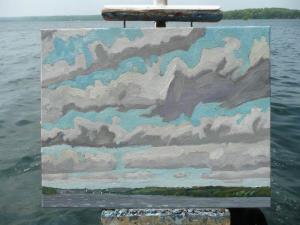Looking for design inspiration? Browse our curated collections!
June 2nd, 2015 - 08:24 AM

Typically virga is comprised of larger ice crystals or snow flakes that have accreted to a large size and start their fall at one meter per second toward the ground. The smaller of these flakes start to either melt or sublimate as they fall into warmer temperatures. If they melt into tiny water droplets, they occupy less of the volume of the air and become less visible to the eye. If they sublimate directly into water vapour, these tiny flakes simply vanish. Should the tiny water droplets collide and grow into larger droplets of rain, they fall faster at speeds up to ten metres per second or so. These larger and faster rain drops also occupy less space per volume of air.
The same processes occur to the larger snow flakes leaving the cloud base but it take more time to exchange the energy required for the change of states. This delay makes for interesting shapes in the wispy tails of cloud spiraling earth bound.
Regardless which process dominates, the dark virga comprised of snow flakes leaving the cloud base simply disappear before they get to the ground. Sometimes some of the larger rain drops actually do make it to the ground and you might be struck by a large, convective rain drop out of the blue. In this case, the virga is no longer "virga" but has evolved into a shower.
Comments
There are no comments on this blog. Click here to post the first comment.